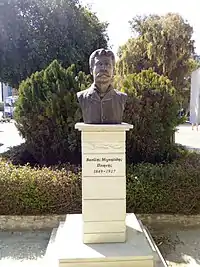Vasilis Michaelides | |
|---|---|
 Bust of Michailides in Strovolos | |
| Born | c. 1849 Geçitkale/Lefkonuk, Sanjak of Cyprus, Eyalet of the Archipelago, Ottoman Empire (today Lefkoniko, Cyprus) |
| Died | 18 December 1917 Limassol, British Cyprus |
| Occupation | Poet |
| Nationality | Cypriot |
Vasilis Michaelides (Greek: Βασίλης Μιχαηλίδης, before c. 1849 –18 December 1917) is considered by many and often referred to as the national poet of Cyprus.[1][2]
Michaelides was born in Lefkoniko, a village in the Famagusta District of Cyprus in 1849. In 1862 he moved to Nicosia to attend Secondary School. His first contact with the arts came in the form of religious icons in the archbishopric in Nicosia, where he trained as an artist. He subsequently moved to the Diocese of Larnaca where concentrated on painting in the care of his uncle. In 1873 he published his first poems "Usury" (Greek: Η Τοκογλυφία) and "Nightingales and Owls" (Greek: Αηδόνια και Κουκουβάγιες) and in 1875 he moved to Naples, Italy for further studies in painting. Michaelides left Italy in 1877 and went to Greece where he enlisted as a volunteer in the Greek army and fought for the liberation of Thessaly. With the end of Ottoman rule of Cyprus in 1878, he returned to Limassol, Cyprus, staying at the local premises of the Diocese of Larnaca. There he began to write for the local newspaper "Alithia" (Greek: Αλήθεια "Truth").
Michaelides wrote several poems in Katharevousa, Dhimotiki and the Cypriot Dialect. His first poetry collection, "The Weak Lyre" (Greek: Η Ασθενής Λύρα), was published in 1882. In 1884 he was appointed to work as a nurse thereby securing an income, room and board. He then began to write for the newspaper "Salpinga"(Greek: Σάλπιγγα "Clarion"). In 1888 he began the publication of the satirical magazine "Diavolos" (Greek: Διάβολος "Devil").
In 1883 he wrote "The Fairy" (Greek: Η Ανεράδα), followed by his most famous work "The 9th of July 1821" (Greek: Η 9η Ιουλίου 1821),[2] a poem written in the Cypriot dialect detailing the events leading to the execution of the Greek Cypriot leadership, including Archbishop Kyprianos, by the Ottoman rulers of the time.
Ἀντάν κ̌ί' ἀρκέψαν οἱ κρυφοί ἀνέμοι κ̌ί' ἐφυσούσαν :κ̌ί' ἀρκίνησεν εἴς τήν Τουρκ̌ιάν νά κρυφοσυνεφκιάζη :κ̌αί πού τές τέσσερεις μερκές τά νέφη ἐκουβαλούσαν, :ώστι νά κάμουν τόν κ̌αιρόν ν' ἀρκεύκη νά στοιβάζη, :εἴχ̌εν σγιάν εἴχαν οὕλοι τοῦς κ̌ι ἡ Ǩύπρου τό κρυφόν τῆς :μέσ' στοῦς ἀνέμους τοῦς κρυφούς εἴχ̌εν τό μερτικόν τῆς. :κ̌ί' ἀντάν ἐφάνην ἡ στραπή εἴς τοῦ Μοριά τά μέρη :κ̌ί' ἐξάπλωσεν κ̌ι' ἀκούστηκεν παντού ἡ πουμπουρκά τῆς, :κ̌ί' οὕλα ξηλαμπρακ̌ίσασιν κ̌αί θάλασσα κ̌αί ξέρη :εἴχ̌εν σγιάν εἴχαν οὕλοι τοῦς κ̌ἰ' ἡ Ǩύπρου τά κακά τῆς.
- —from Ἑννάτη Ἰουλίου, Βασίλης Μιχαηλίδης
Michaelides' poetry helped establish Cypriot Greek as a linguistic medium for written poetry.[3]
The "9th of July" was followed by "The Woman From Chios" (Greek: Η Χιώτισσα).
The latter part of his life was plagued by alcoholism. In 1910 he lost his job as a nurse, but the Limassol Municipality gave him a new job as a Health Inspector as well as a room to stay at the town hall. In 1911 he published "Poems" (Greek: Ποιήματα). In 1915 he ended up at the Limassol poorhouse where he wrote "The Dream of the Greek" (Greek: Το όρομαν του Ρωμιού).
He died penniless and an alcoholic on 18 December 1917.
In 1978, his portrait was depicted on one of a series of stamps themed on Cypriot poets.
References
- ↑ Arabatzis, Georgios; Mitralexis, Sotiris; Steiris, Georgios (2016-04-26). The Problem of Modern Greek Identity: From the Ecumene to the Nation-State. Cambridge Scholars Publishing. ISBN 978-1-4438-9282-7.
- 1 2 Ioannides, Christos P. (2018-12-06). Cyprus under British Colonial Rule: Culture, Politics, and the Movement toward Union with Greece, 1878–1954. Lexington Books. p. 12. ISBN 978-1-4985-8203-2.
- ↑ "Vasilis Michaelides: A Tribute to the National Poet of Cyprus". www.greeknewsagenda.gr. Retrieved 2023-03-30.
External links
- Full text of "The 9th of July 1821" in Cypriot dialect and English translation
- Cyprus Stamp Issue: Cypriot Poets: Demetrios Lipertis and Vasilis Michaelides